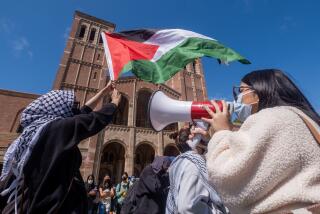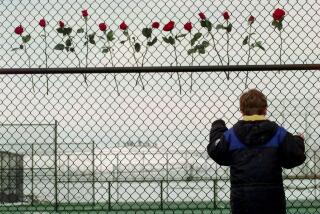Stop the Violence; Kids Are Watching
- Share via
When the “teenage superpredators,” the youth who occupied so many of our headlines before Sept. 11, look to the adult caretakers of their larger society, they find many examples of violent conflict resolution.
While their leaders were still bombing Yugoslavia, two teenagers, Eric Harris and Dylan Klebold, killed classmates, a teacher and themselves in Colorado. In the immediate wake of the Columbine shootings in April 1999, former President Clinton urged Americans to teach our children to resolve conflict “without resorting to violence.”
This was clearly not the goal of his administration’s policy on the crisis in Kosovo. The effects of U.S. economic sanctions on Iraq were also violent, as was made clear in 1996 when Secretary of State Madeleine Albright told Leslie Stahl of “60 Minutes” that the deaths of half a million Iraqi children were “worth it.”
Nor is nonviolent conflict resolution the goal of the current administration, which put us at war while we were still in the throes of grief. If our government and we, as adult society, continue to respond to conflict with violence, we shouldn’t be surprised when our kids do the same. If some brave teenagers who have been beaten every day of their childhood years can learn how to handle conflict nonviolently, surely a country with as many resources as the United States can teach its leaders to do the same.
We tell kids in the juvenile correctional system that nonviolent alternatives provide more effective solutions. These alternatives require considerable self-reflection and real courage--not the anger and wish to take control that masquerade as courage.
I tell the teens with whom I volunteer that violence doesn’t solve problems; it simply destroys, and creates more problems. Lately, I’m having to explain that to wounded and angry teenagers who identify with a wounded and angry country that is bombing Afghanistan.
Like many of our kids who have been abused, we are faced with a daunting task. How do we express anger and grief or handle the trauma and the yearning for justice without escalating the pattern of violence, without leaving future generations with a legacy that will engender more and more destruction? And why is the flag that draws so many together also a flag that is a symbol of violence and injustice to many others around the world (not only members of the Taliban or Osama bin Laden’s network) who perceive the United States as unilaterally unfair and may even see our flag waving as something analogous to flashing gang signs?
In the current situation, our government chose to bypass international institutions specifically designed to address an incident such as what happened on Sept. 11. Because the United States often has insisted that other nations abide by venues such as international courts, international tribunals or U.N. sanctions, our decision to pursue military means could seem to send the message that these international standards apply to everyone but the United States.
To really answer any of these questions after Sept. 11, we need to engage in a kind of self-reflection that is never easy. But it is possible. I’ve watched some teenagers with very limited resources and support, kids who know what it means to hurt and feel helpless, learn alternatives to violence. If they can do it, surely we all can.
And if we don’t, we shouldn’t blame our kids for having a hard time with the command to “do what we say and not what we do.”
More to Read
Get the L.A. Times Politics newsletter
Deeply reported insights into legislation, politics and policy from Sacramento, Washington and beyond. In your inbox twice per week.
You may occasionally receive promotional content from the Los Angeles Times.










